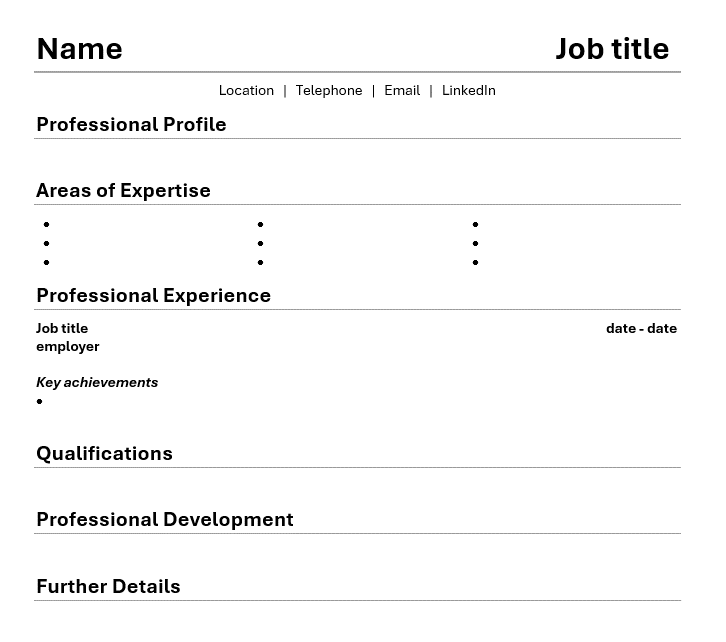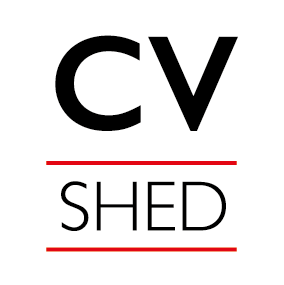What CV headings do I need?
Faced with a blank screen and an illustrious career, it can be hard to know where to start when you need a CV. Luckily, CV Shed has a handy tip for you. As with any overwhelming task, it’s easier if you break it down into smaller chunks. Let’s get rid of the blank screen by starting with some CV headings!
By putting some headings in position, you’ll be able to make a strong start and get a structure in place, that you simply need to fill out later with the facts. In this article, you’ll find out what CV headings you need and learn some handy hints for formatting them. There’s even a CV heading example template!
What are the main CV headings?
Without further ado, let’s think about the key headings you need to include on your CV. Every good CV will have:
- Main heading
- Profile, Summary or Personal Statement
- Key Skills, Core Competencies or Areas of Expertise
- Career History
- Qualifications or Education
As you can see, some of these headings have more than one option. It doesn’t matter, for example, whether you call your skills section “Key Skills”, “Core Competencies” or “Areas of Expertise” – it’s just a signpost to the reader to make your CV easier to navigate. As long as the section is there and clearly headed, you have nothing to worry about.
What should I include under each heading?
Getting the CV headings in place is one thing – knowing what to add to each section is another. Here’s a quick rundown:
- Main heading. Add your name in large text, plus a professional title and your contact information in a standard-size font underneath.
- Profile, Summary or Personal Statement. Use 4-5 lines to say what you do, what you specialise in and why a company will benefit from employing you.
- Key Skills, Core Competencies or Areas of Expertise. List 6-12 key skills based on the requirements of the job advert and your career strengths, with a focus on hard skills.
- Career history. Add each role you’ve held in reverse chronological order, giving job titles, employer names, dates, overall remit and achievements for each.
- Qualifications or Education. Include your highest-level qualification, including level, subject and year, plus university name for degrees.
What other CV headings can I use?
Depending on your situation, you could boost your candidacy with some additional sections. Have you considered:
- Early Career
- Volunteering
- Publications
- Professional Development
- Awards
- Professional Memberships
- IT Skills
- Languages
If any of these sections would enhance your appeal to a recruiter, go ahead and add them!
What should my CV headings look like?
Your CV headings need to stand out, to make your CV easy to navigate. Choose a standard, sans serif font (serifs are the flicky bits on the tops and bottoms of letters – they can make a document look dated and are harder to read on a screen). Arial and Calibri are always popular choices.
The headers should naturally be larger than the rest of the text on your CV (think 12-18 point) so that they stand out. As for alignment, it doesn’t really matter – left, centre or even right aligned can all work.
A splash of colour is fine, but don’t be tempted by text boxes or graphics – they won’t help your cause at all. Keep it simple, clean and, above all, professional.
What headings should I not use?
Now you know exactly what to do – but what about what NOT to do? Don’t be tempted to add these headers to your CV:
- Curriculum vitae. It’s obvious what the document is, just dive straight in with your name.
- Objective. This is outdated – the CV should focus on what you can offer, not what you want.
- References. They simply aren’t required at this stage – use the space for something more compelling.
CV heading example
Don’t say I don’t spoil you – here’s how your blank screen should look now you’ve added your CV headers.

Now you’re no longer faced with a blank screen and you’ve got a structure in place for your CV, with an idea of what to write in each section. Hopefully the CV writing process seems a lot less overwhelming now!
If not, never fear – CV Shed is here to take the pain out of job applications. With options at various price points, you’re sure to find the help you need to make your next career move. With a professional CV tailored to your ideal next step, you’ll find that a CV Shed CV increases your confidence and opens doors!




